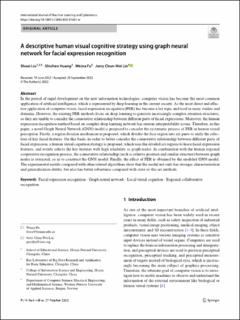| dc.description.abstract | In the period of rapid development on the new information technologies, computer vision has become the most common application of artificial intelligence, which is represented by deep learning in the current society. As the most direct and effective application of computer vision, facial expression recognition (FER) has become a hot topic and used in many studies and domains. However, the existing FER methods focus on deep learning to generate increasingly complex attention structures, so they are unable to consider the connotative relationship between different parts of facial expressions. Moreover, the human expression recognition method based on complex deep learning network has serious interpretability issues. Therefore, in this paper, a novel Graph Neural Network (GNN) model is proposed to consider the systematic process of FER in human visual perception. Firstly, a region division mechanism is proposed, which divides the face region into six parts to unify the selection of key facial features. On this basis, in order to better consider the connotative relationship between different parts of facial expression, a human visual cognition strategy is proposed, which uses the divided six regions to learn facial expression features, and evenly selects the key features with high reliability as graph nodes. In combination with the human regional cooperative recognition process, the connotative relationship (such as relative position and similar structure) between graph nodes is extracted, so as to construct the GNN model. Finally, the effect of FER is obtained by the modeled GNN model. The experimental results compared with other related algorithms show that the model not only has stronger characterization and generalization ability, but also has better robustness compared with state-of-the-art methods. | en_US |

